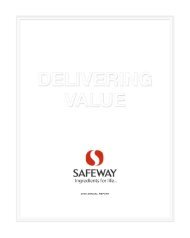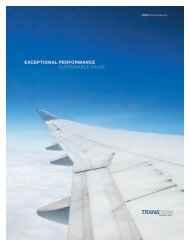Bemis Company 2007 Annual Report - IR Solutions
Bemis Company 2007 Annual Report - IR Solutions
Bemis Company 2007 Annual Report - IR Solutions
Create successful ePaper yourself
Turn your PDF publications into a flip-book with our unique Google optimized e-Paper software.
(5) Purchase obligations represent contracts or commitments for the purchase of raw materials, utilities, capital equipment and<br />
various other goods and services.<br />
(6) Postretirement obligations represent contracts or commitments for postretirement healthcare benefits and benefit payments for<br />
the unfunded <strong>Bemis</strong> Supplemental Retirement Plan. See Note 7 to the Consolidated Financial Statements for additional<br />
information about our postretirement benefit obligations.<br />
Interest Rate Swaps<br />
Our long-term unsecured notes include $250 million due in August 2008. In September 2001, we entered into interest rate swap<br />
agreements with two U.S. banks, which increased our exposure to variable rates. We generally prefer variable rate debt since it has been<br />
our experience that borrowing at variable rates is less expensive than borrowing at fixed rates over the long term. These interest rate swap<br />
agreements, which expire in 2008, reduced the interest cost of the $250 million of long-term debt from 6.5 percent to about 6.0 percent in<br />
<strong>2007</strong>. Since these variable rates are based upon six-month London Interbank Offered Rates (LIBOR), calculated in arrears, at the<br />
semiannual interest payment dates of the corresponding notes, increases in short-term interest rates will directly impact the amount of<br />
interest we pay.<br />
Accounting principles generally accepted in the United States of America require that the fair value of these swaps, which have<br />
been designated as hedges of our fixed rate unsecured notes outstanding, be recorded as an asset or liability of the <strong>Company</strong>. The fair<br />
value of these swaps was recorded as an asset of $3.3 million at December 31, <strong>2007</strong>, and an asset of $2.5 million at December 31, 2006.<br />
For each period, an offsetting increase is recorded in the fair value of the related long-term notes outstanding. These fair value<br />
adjustments do not impact the actual balance of outstanding principal on the notes, nor do they impact the income statement or related<br />
cash flows. Credit loss from counterparty nonperformance is not anticipated.<br />
Market Risks and Foreign Currency Exposures<br />
We enter into contractual arrangements (derivatives) in the ordinary course of business to manage foreign currency exposure<br />
and interest rate risks. We do not enter into derivative transactions for trading purposes. Our use of derivative instruments is subject to<br />
internal policies that provide guidelines for control, counterparty risk, and ongoing reporting. These derivative instruments are designed<br />
to reduce the income statement volatility associated with movement in foreign exchange rates, establish rates for future issuance of public<br />
bonds, and to achieve greater exposure to variable interest rates.<br />
Interest expense calculated on our outstanding debt is substantially subject to short-term interest rates. As such, increases in<br />
short-term interest rates will directly impact the amount of interest we pay. For each one percent increase in variable interest rates, the<br />
annual interest expense on $533.9 million of variable rate debt outstanding would increase by $5.3 million.<br />
Our international operations enter into forward foreign currency exchange contracts to manage foreign currency exchange rate<br />
exposures associated with certain foreign currency denominated receivables and payables. At December 31, <strong>2007</strong> and 2006, we had<br />
outstanding forward exchange contracts with notional amounts aggregating $5.0 million and $3.5 million, respectively. Forward<br />
exchange contracts generally have maturities of less than six months. Counterparties to the forward exchange contracts are major<br />
financial institutions. Credit loss from counterparty nonperformance is not anticipated. We have not designated these derivative<br />
instruments as hedging instruments. The net settlement amount (fair value) related to the active forward foreign currency exchange<br />
contacts is insignificant and recorded on the balance sheet within current liabilities and as an element of other costs (income), net, which<br />
offsets the related transactions gains and losses on the related foreign denominated asset or liability.<br />
The operating results of our international operations are recorded in local currency and translated into U.S. dollars for<br />
consolidation purposes. The impact of foreign currency translation on net sales was an increase of $123.2 million in <strong>2007</strong> and $63.3<br />
million in 2006. Operating profit improved by approximately $9.6 million in <strong>2007</strong> and $7.0 million in 2006 as a result of the positive<br />
effect of foreign currency translation.<br />
Long-term Compensation<br />
Our practice of awarding long-term compensation has relied primarily on restricted stock unit programs that are valued at the<br />
time of the award and expensed over the vesting period. Beginning in 2004, we discontinued the awarding of stock options. Stock<br />
options granted prior to 2004 were granted at prices equal to the fair market value on the date of grant and exercisable, upon vesting, over<br />
varying periods up to ten years from the date of grant. Stock options for Directors vested immediately, while options for <strong>Company</strong><br />
employees generally become vested over three years (one-third per year). Beginning January 1, 2006, accounting rules require us to<br />
follow a fair value based method of recognizing expense for stock options. The impact to diluted earnings per share for stock options<br />
expense in 2006 was insignificant. If we had followed this fair value method prior to 2006, the negative impact on diluted earnings per<br />
share would have been one cent for the year ended 2005.<br />
Critical Accounting Estimates and Judgments<br />
Our discussion and analysis of our financial condition and results of operations is based upon our consolidated financial<br />
statements, which have been prepared in accordance with accounting principles generally accepted in the United States. The preparation<br />
of these financial statements requires us to make estimates and assumptions that affect the reported amounts of assets and liabilities and<br />
the disclosure of contingent assets and liabilities at the date of the financial statements and the reported amounts of expenses during the<br />
reporting period. On an ongoing basis, management evaluates its estimates and judgments, including those related to retirement benefits,<br />
intangible assets, goodwill, and expected future performance of operations. Our estimates and judgments are based upon historical<br />
experience and on various other factors that are believed to be reasonable under the circumstances. Actual results may differ from these<br />
estimates under different assumptions or conditions.<br />
15







